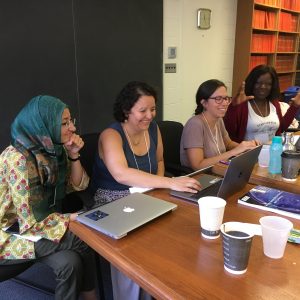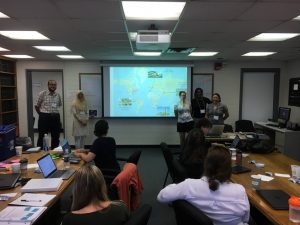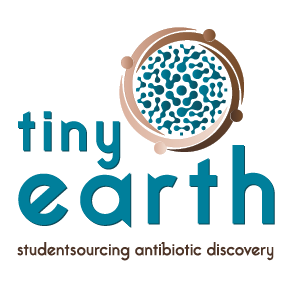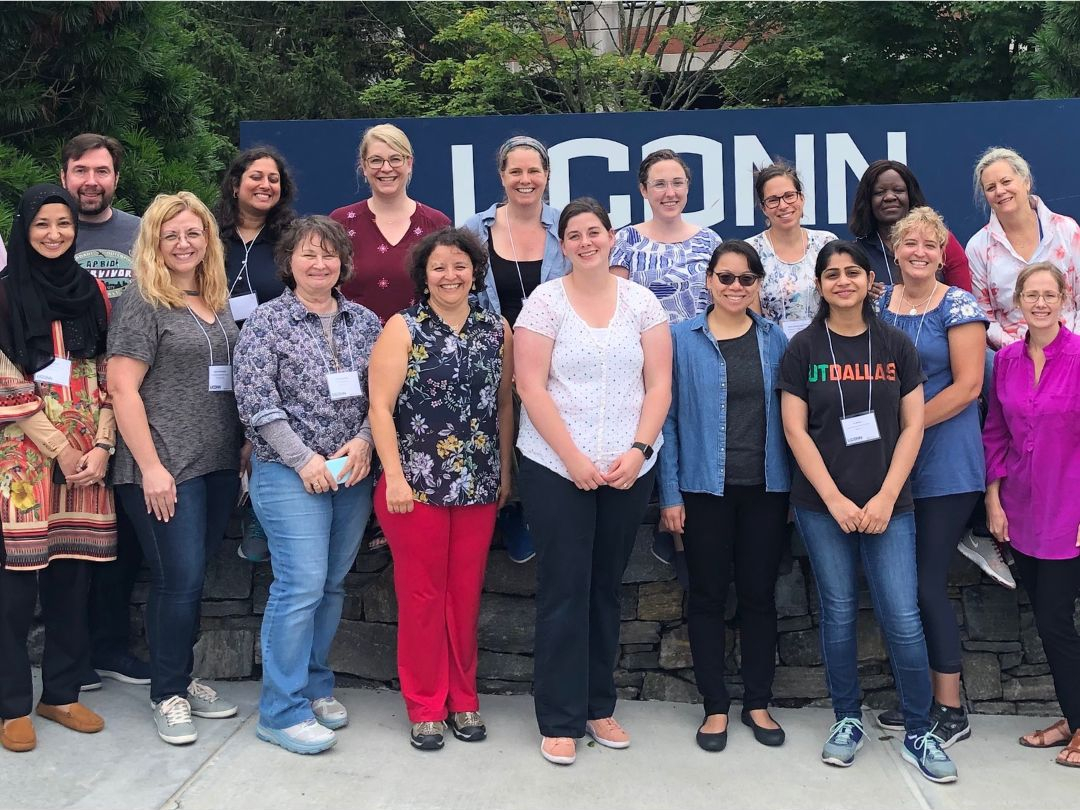Tiny Earth’s newest class of partner instructors are charting new territory for the program, expanding its global reach and adding high school instructors to the effort to studentsource antibiotic discovery. Twenty high school, community college, and university science instructors from 12 US states and five countries convened for the Tiny Earth Partner Instructor (TEPI) training at the University of Connecticut in July. The group was led by Nichole Broderick, Debra Davis, Sarah Miller, and Barbarah Murdoch. They met for instructional and collaborative sessions on Tiny Earth curriculum, including laboratory skills, pedagogy, and involvement in the Tiny Earth network’s collective effort to mitigate two pressing global issues: the antibiotic resistance crisis and the need for a larger STEM workforce. The newly-trained TEPIs will join hundreds of other instructors as they implement the Tiny Earth course in their classrooms this coming academic year.
As the Tiny Earth network expands, it is increasingly reaching new audiences beyond colleges and universities. Tami Caraballo plans to implement the curriculum during her second semester Advanced Molecular Biology for Global Health class at Glacier Peak High School in Snohomish, WA. During the first semester of this course, students work through the University of Washington’s Global Health 101 material while learning and refining basic biotech lab skills. The second semester is focused on a student-driven research project that challenges the students to make a positive impact upon public health, particularly around the UN Sustainable Development Goals (UNSDG)—a perfect fit for Tiny Earth.
“The antibiotic crisis is a perfect hook for these kids. They are fundamentally curious and really want to believe that their work is meaningful,” Caraballo says.
Aaron Mathieu is also introducing the curriculum to secondary students in his AP Biology course at Acton-Boxborough Regional High School in Acton, MA. Using some of the core elements of the Tiny Earth course, Mathieu is looking forward to seeing the curriculum in the hands of his students.
“There are so many areas that this curriculum touches on and students should be able to learn a wide range of scientific concepts, science practices, and lab skills and we implement this project,” Mathieu says. “It can sometimes feel overwhelming to students when they learn about global problems, like the rise of antibiotic resistance, [but] this project should feel empowering as they will be part of the community looking for solutions.”
The training also provided opportunities for a group of passionate and engaged science teachers to generate ideas and share expertise among fellow instructors.
“[At the training,] I definitely felt like I was working with a community of educators who were working together to learn, reflect, and support one another,” Mathieu adds. “Having the opportunity to work through all of the techniques in a college lab side-by-side with other high school teachers was very helpful. It was also powerful to have the collection of college professors and graduate students to help with content background and technical expertise as we learned throughout the week. I enjoyed networking with educators from all over the globe, [and] I felt like I was able to bring teaching expertise to the group to contribute to the conversations.”

Saima Khalid, Pilar Junier, Saskia Bindschedler, and Lesedi Lebogang
In addition to networking, the training provided instructors a glimpse at how they can tailor the curriculum to local environments. Lesedi Lebogang, a lecturer at Botswana International University of Science and Technology in Central District, Botswana, plans to take advantage of the unique soil locations in Botswana that have not yet been explored for bioactive compounds, such as the saltpans, mine waste dumps, and swamps from the Delta.
“Doing Tiny Earth as a project to teach microbiology techniques through the development of scientific project will promote interest in laboratory practicals. This also provides a good opportunity to explore Botswana’s different habitats,” Lebogang says.
In addition to implementing the course in her university classroom, Lebogang will also boost girls’ participation in science via implementation of Tiny Earth through Girls Excelling in Math and Science (GEMS), where high school girls are invited to spend a summer doing a residency in with women lecturers.
“Antibiotic discovery from microorganisms will demystify the perception that microorganisms are the bad guys, but they can also be source of bioactive compounds and excite the girls to come and [study] science at university,” Lebogang says.
Laura Williams of Providence College in Providence, Rhode Island, previously taught Tiny Earth in a microbiology course and enjoys how the curriculum engages students and motivates them to solve a problem that they will see again, even if they do not continue in a health profession. After attending the training this summer, she has a clearer idea of how to successfully integrate the content in her lab and get results.

Ahmed El Salous, Saima Khalid, Saskia Bindschedler, Lesedi Lebogang, and Pilar Junier in front of Tiny Earth’s international map of partner institutions
“I was really happy to be able to participate in training after teaching the course,” Williams says. “Some techniques were familiar, but others like chemical extractions and eukaryotic toxicity tests were new. I got to get a chance to work on [those things] and ask questions among a cohort of people teaching the course.”
This year, hundreds of new students, taught by the recently trained TEPIs, will join the effort to crowdsource antibiotic discovery in classrooms worldwide, including those in Switzerland. Pilar Junier, a professor at Université de Neuchâtel in Neuchâtel, Switzerland, will incorporate the curriculum for pre- and post-secondary students. Alongside Université de Neuchâtel lecturer Saskia Bindschedler, Junier will tailor the Tiny Earth curriculum to include fungi, emphasizing bacterial-fungal interactions.
“We believe there is a massive potential in Switzerland,” Junier notes. “We want to include the concept of service learning as part of the implementation and then the idea of crowdsourcing and crowdfunding for the long-term. We also believe that it is essential to engage more with society and the [Tiny Earth Partner Instructor] training really fostered this idea.”
Featured image: Back row L to R: Ahmad El Salous (Ciencias Agrarias, Ecuador), Aaron Mathieu (Acton-Boxborough Regional High School, MA), Divya Nagri (Nashua High School North, NH), Sarah Miller (Tiny Earth Executive Director, Univ. of Wisconsin-Madison), Elizabeth Bone (Clark University, MA), Elizabeth Suter (Wagner College, NY), Saskia Bindschedler (Université of Neuchátel, Switzerland), Lesedi Lebogang (Botswana Int’l Univ. of Science and Technology, Botswana), Tami Caraballo (Glacier Peak High School, WA). Front row L to R: Nichole Broderick (Tiny Earth Science and Training Director, Univ. of Connecticut), Saima Khalid (Women University Mardan, Pakistan), Monica Hall-Woods (St. Charles Community College, MO), Orianna Carter (Ohio University, OH), Pilar Junier (Université of Neuchátel, Switzerland), Stephanie Lambeth Mathews (Campbell University, NC), Sonia Chin (Friends’ Central School, PA), Ita Mehta (University of Texas at Dallas, TX), Francine Brown (Nashua High School North, NH), LeAnna Willison (Thomas University, GA), Laura Williams (Providence College, RI), John Rohde (Dalhousie University, Canada), Debra Davis (Tiny Earth Training Committee Chair, Wingate University). Not pictured: Samatha vanCleave (Clark University, MA).


